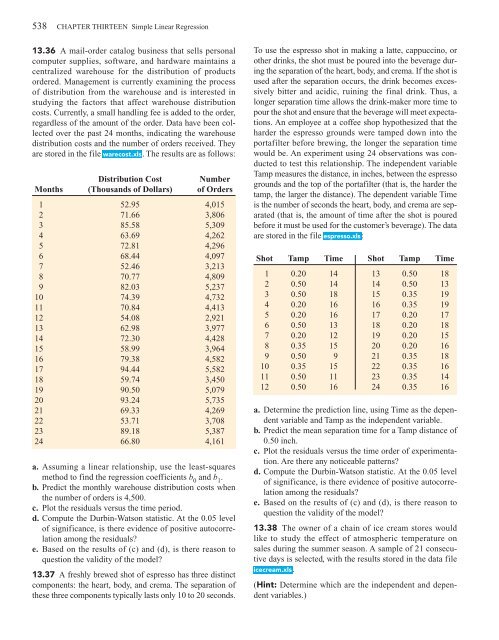CHAPTER 13 Simple Linear Regression
CHAPTER 13 Simple Linear Regression
CHAPTER 13 Simple Linear Regression
Create successful ePaper yourself
Turn your PDF publications into a flip-book with our unique Google optimized e-Paper software.
538 <strong>CHAPTER</strong> THIRTEEN <strong>Simple</strong> <strong>Linear</strong> <strong>Regression</strong><br />
<strong>13</strong>.36 A mail-order catalog business that sells personal<br />
computer supplies, software, and hardware maintains a<br />
centralized warehouse for the distribution of products<br />
ordered. Management is currently examining the process<br />
of distribution from the warehouse and is interested in<br />
studying the factors that affect warehouse distribution<br />
costs. Currently, a small handling fee is added to the order,<br />
regardless of the amount of the order. Data have been collected<br />
over the past 24 months, indicating the warehouse<br />
distribution costs and the number of orders received. They<br />
are stored in the file warecost.xls. The results are as follows:<br />
Distribution Cost Number<br />
Months (Thousands of Dollars) of Orders<br />
1 52.95 4,015<br />
2 71.66 3,806<br />
3 85.58 5,309<br />
4 63.69 4,262<br />
5 72.81 4,296<br />
6 68.44 4,097<br />
7 52.46 3,2<strong>13</strong><br />
8 70.77 4,809<br />
9 82.03 5,237<br />
10 74.39 4,732<br />
11 70.84 4,4<strong>13</strong><br />
12 54.08 2,921<br />
<strong>13</strong> 62.98 3,977<br />
14 72.30 4,428<br />
15 58.99 3,964<br />
16 79.38 4,582<br />
17 94.44 5,582<br />
18 59.74 3,450<br />
19 90.50 5,079<br />
20 93.24 5,735<br />
21 69.33 4,269<br />
22 53.71 3,708<br />
23 89.18 5,387<br />
24 66.80 4,161<br />
a. Assuming a linear relationship, use the least-squares<br />
method to find the regression coefficients b 0<br />
and b 1<br />
.<br />
b. Predict the monthly warehouse distribution costs when<br />
the number of orders is 4,500.<br />
c. Plot the residuals versus the time period.<br />
d. Compute the Durbin-Watson statistic. At the 0.05 level<br />
of significance, is there evidence of positive autocorrelation<br />
among the residuals?<br />
e. Based on the results of (c) and (d), is there reason to<br />
question the validity of the model?<br />
<strong>13</strong>.37 A freshly brewed shot of espresso has three distinct<br />
components: the heart, body, and crema. The separation of<br />
these three components typically lasts only 10 to 20 seconds.<br />
To use the espresso shot in making a latte, cappuccino, or<br />
other drinks, the shot must be poured into the beverage during<br />
the separation of the heart, body, and crema. If the shot is<br />
used after the separation occurs, the drink becomes excessively<br />
bitter and acidic, ruining the final drink. Thus, a<br />
longer separation time allows the drink-maker more time to<br />
pour the shot and ensure that the beverage will meet expectations.<br />
An employee at a coffee shop hypothesized that the<br />
harder the espresso grounds were tamped down into the<br />
portafilter before brewing, the longer the separation time<br />
would be. An experiment using 24 observations was conducted<br />
to test this relationship. The independent variable<br />
Tamp measures the distance, in inches, between the espresso<br />
grounds and the top of the portafilter (that is, the harder the<br />
tamp, the larger the distance). The dependent variable Time<br />
is the number of seconds the heart, body, and crema are separated<br />
(that is, the amount of time after the shot is poured<br />
before it must be used for the customer’s beverage). The data<br />
are stored in the file espresso.xls:<br />
Shot Tamp Time Shot Tamp Time<br />
1 0.20 14 <strong>13</strong> 0.50 18<br />
2 0.50 14 14 0.50 <strong>13</strong><br />
3 0.50 18 15 0.35 19<br />
4 0.20 16 16 0.35 19<br />
5 0.20 16 17 0.20 17<br />
6 0.50 <strong>13</strong> 18 0.20 18<br />
7 0.20 12 19 0.20 15<br />
8 0.35 15 20 0.20 16<br />
9 0.50 9 21 0.35 18<br />
10 0.35 15 22 0.35 16<br />
11 0.50 11 23 0.35 14<br />
12 0.50 16 24 0.35 16<br />
a. Determine the prediction line, using Time as the dependent<br />
variable and Tamp as the independent variable.<br />
b. Predict the mean separation time for a Tamp distance of<br />
0.50 inch.<br />
c. Plot the residuals versus the time order of experimentation.<br />
Are there any noticeable patterns?<br />
d. Compute the Durbin-Watson statistic. At the 0.05 level<br />
of significance, is there evidence of positive autocorrelation<br />
among the residuals?<br />
e. Based on the results of (c) and (d), is there reason to<br />
question the validity of the model?<br />
<strong>13</strong>.38 The owner of a chain of ice cream stores would<br />
like to study the effect of atmospheric temperature on<br />
sales during the summer season. A sample of 21 consecutive<br />
days is selected, with the results stored in the data file<br />
icecream.xls.<br />
(Hint: Determine which are the independent and dependent<br />
variables.)

















